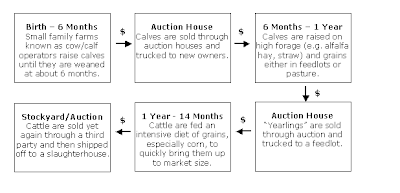
My colleagues, Carl and Christopher Cosack, visited a Colorado ranch recently and sent me back some samples of the ranch’s dry-aged, grain-finished Charolais and Charolais-cross rib-eye steaks. I was saving the steaks for a special blind taste testing party but my husband didn't know this and accidentally cooked one up.
Hats off to the Elliott and Ferris families who raised this beef. The steak was full of flavor -- it even stood up to some fairly strong competition from the Montreal Steak salt used as a marinade. And it was plenty tender.
It’s worth noting that we cooked up a strip loin from our local butcher alongside the rib-eye. Not a perfectly fair comparison but the strip loin was milder tasting and thus in my opinion a bit overwhelmed by the marinade. FYI, the butcher couldn’t tell us the breed but based on my experience with taste testing, the strip loin was likely Angus-cross, as Angus influence seems to produce a lighter flavor (bland to me, yummy to others.)
Anyway, if you happen to like steak with a lot of flavor, try to get your hands on some dry-aged Charolais beef.

Suspect the best way to enjoy the steaks is to serve them naked – once they’re cooked, drizzle a little olive oil and maybe a squeeze of lemon and a dusting of sea salt. But if you want a simple twist, here’s a simple recipe:
Ingredients:
Charolais or Charolais-cross Rib Eye Steaks
At least 1” thick and preferably dry-aged 14-21 days
Montreal Steak salt (MSG-free)
Worcestershire Sauce (we use Lea & Perrins)
Hickory Chips
Aluminum Foil
Preparation:
Generously sprinkle both sides of the steaks with Montreal Steak salt and Worcestershire sauce. Let marinade at room temperature (covered) about 15 minutes while you prepare the grill.
Pre-heat gas or charcoal grill to high (about 475 F). While it’s heating, put a handful or two of hickory chips in a 12” section of foil and fold in the sides and top to create a pouch. Punch 10-20 small holes in the foil pouch and place it on the grill. It will start to smoke.
Sear the steaks on one side for 2-3 minutes (lid closed) and then flip them with a spatula or tongs and reduce the heat to medium high (about 400 F). Grill the steaks to rare or medium rare (or more if you like, though you’ll lose some flavor and tenderness). Let steaks rest at least 5 minutes before cutting and then serve ‘em up, sliced or whole.
Feel free of course to use your own grilling techniques. Just don’t pierce the steaks while they’re cooking or resting or you’ll lose the juices that keep it moist.
Note: I personally recommend that you choose from farm or ranch like
Colorado's Best Beef Company that finishes their beef without the use of synthetic growth enhancers (e.g. sub-therapeutic antibiotics or growth hormones). At minimum, they can negatively influence the taste and tenderness of the meat.
 This is one of the most fascinating and powerful arguments I've ever heard about why we need to pay close attention to the food we eat.
This is one of the most fascinating and powerful arguments I've ever heard about why we need to pay close attention to the food we eat.













